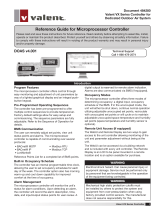
Form CP-AHU D19_D21_D22 (11-17), D303072-A, Page 14
6.3.1 Electric Heat Staging
Electric heat staging will start when the discharge air temperature is 5°F(2.8°C) below the
active setpoint and the OAT is below the (Heating Lockout SP). The PID loop will activate
and the unit will stage as shown in the staging chart to maintain the active discharge air
setpoint. The units may be equipped with up to six stages of electric heat. The number of
stages and modulated capacity control is determined by the model, series, and heating
size.
Electric Heat Staging
PID Loop Control: All Statements Must Be True To Activate or De-Activate.
All stages will have an adjustable min ON and OFF time.
Stage Outputs
Increase
Inter-Stg
Timer
Activate
Decrease
Inter-Stg
Timer
De-activate
Stg 1 NO6 = ON N/A
DAT 5°F (2.8°C) below setpoint
(Y3 Modulates via Heating Demand)
See NOTE 1
15 min. For
modulated
systems. 5 min.
for non modu-
lated systems.
See NOTE 3
Heating Demand < 2.5% & DAT 5°F
(2.8°C) above setpoint
Stg 2 NO7 = ON 5 min
Heating Demand > 70% & DAT
5°F(2.8°C) below setpoint
5 min
Heating Demand < 5% & DAT
5°F(2.8°C) above setpoint
Stg 3 NO8 = ON 5 min
Heating Demand > 75% & DAT
5°F(2.8°C) below setpoint
5 min
Heating Demand < 10% & DAT
5°F(2.8°C) above setpoint
Stg 4 NO9 = ON 5 min
Heating Demand > 80% & DAT
5°F(2.8°C) below setpoint
5 min
Heating Demand < 20% & DAT
5°F(2.8°C) above setpoint
Stg 5 NO10 = ON 5 min
Heating Demand > 85% & DAT
5°F(2.8°C) below setpoint
5 min
Heating Demand < 30% & DAT
5°F(2.8°C) above setpoint
Stg 6 NO11 = ON 5 min
Heating Demand > 90% & DAT
5°F(2.8°C) below setpoint
5 min
Heating Demand < 40% & DAT
5°F(2.8°C) above setpoint
NOTE 1 Y3 Capacity modulation only applies to units equipped with SCR Controllers.
6.3.2 General Gas Heat Staging
Gas heat staging will start when the discharge air temperature is 5°F(2.8°C) below
the active setpoint and the OAT is below the (Heating Lockout SP). The PID loop will
activate and the unit will stage as shown in the staging chart to maintain the active
discharge air setpoint. The units may be equipped with up to six stages of gas heat.
The number of stages and modulated capacity control is determined by the model,
series, and heating size.
6.3 Heating Control
General Gas Heat Staging
PID Loop Control: All Statements Must Be True To Activate or De-Activate.
All stages will have an adjustable min ON and OFF time.
Stage Outputs
Increase
Inter-Stg
Timer
Activate
Decrease
Inter-Stg
Timer
De-activate
Stg 1
NO6 = ON
Y3 = to light off %
value for 30 sec-
onds & NO6 = ON
See NOTE 1
N/A
DAT 5°F (2.8°C) below
setpoint (Y3 Modulates Heat
Exchanger 1 via (Heating Demand)
See NOTE 2
15 min. For
modulated
systems. 5 min.
for non modu-
lated systems.
See NOTE 3
Heating Demand < 2.5% & DAT
5°F (2.8°C) above setpoint
Stg 2 NO7 = ON 5 min
Heating Demand > 70% & DAT
5°F(2.8°C) below setpoint
5 min
Heating Demand < 5% & DAT
5°F(2.8°C) above setpoint
Stg 3 NO8 = ON 5 min
Heating Demand > 75% & DAT
5°F(2.8°C) below setpoint
5 min
Heating Demand < 10% & DAT
5°F(2.8°C) above setpoint
Stg 4 NO9 = ON 5 min
Heating Demand > 80% & DAT
5°F(2.8°C) below setpoint
5 min
Heating Demand < 20% & DAT
5°F(2.8°C) above setpoint
Stg 5 NO10 = ON 5 min
Heating Demand > 85% & DAT
5°F(2.8°C) below setpoint
5 min
Heating Demand < 30% & DAT
5°F(2.8°C) above setpoint
Stg 6 NO11 = ON 5 min
Heating Demand > 90% & DAT
5°F(2.8°C) below setpoint
5 min
Heating Demand < 40% & DAT
5°F(2.8°C) above setpoint
NOTE 1 Light off value for natural gas = 100% Light off value for Propane = 100%
NOTE 2 Y3 Capacity modulation applies only to units equipped with modulating gas valves.
NOTE 3 15 min timer used on modulated systems to allow capacity control to achieve low re rate.





















